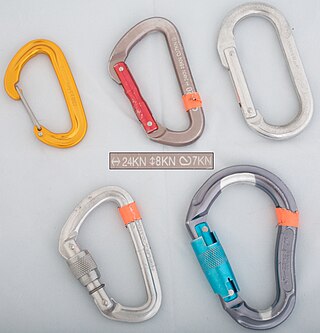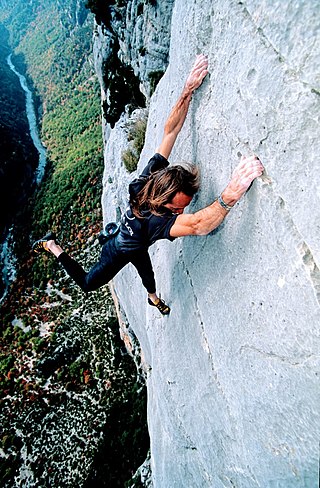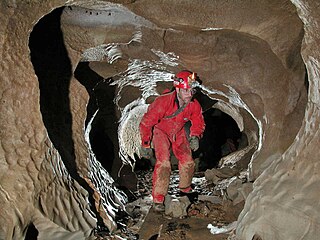
A carabiner or karabiner, often shortened to biner or to crab, colloquially known as a (climbing) clip, is a specialized type of shackle, a metal loop with a spring-loaded gate used to quickly and reversibly connect components, most notably in safety-critical systems. The word comes from the German Karabiner, short for Karabinerhaken, meaning "carbine hook," as the device was used by carabiniers to attach their carbines to their belts.

Canyoning is a sport that combines several outdoor sports like rock climbing, hiking, swimming, and rappelling. A canyoneer travels down canyons using a variety of techniques that may include other outdoor activities such as walking, scrambling, climbing, jumping, abseiling (rappelling), and swimming.

A climbing harness is a piece of equipment that allows a climber to tie in to the safety of a rope. It is used in rock and ice climbing, abseiling, and lowering; this is in contrast to other activities requiring ropes for access or safety such as industrial rope work, construction, and rescue and recovery, which use safety harnesses instead.

A rope is a group of yarns, plies, fibres, or strands that are twisted or braided together into a larger and stronger form. Ropes have tensile strength and so can be used for dragging and lifting. Rope is thicker and stronger than similarly constructed cord, string, and twine.

Glossary of climbing terms relates to rock climbing, mountaineering, and to ice climbing.

Rock-climbing equipment varies with the specific type of climbing that is undertaken. Bouldering needs the least equipment outside of climbing shoes, climbing chalk and optional crash pads. Sport climbing adds ropes, harnesses, belay devices, and quickdraws to clip into pre-drilled bolts. Traditional climbing adds the need to carry a "rack" of temporary passive and active protection devices. Multi-pitch climbing, and the related big wall climbing, adds devices to assist in ascending and descending fixed ropes. Finally, aid climbing uses unique equipment to give mechanical assistance to the climber in their upward movement.

Abseiling, also known as rappelling, is the controlled descent of a steep slope, such as a rock face, by moving down a rope. When abseiling, the person descending controls their own movement down a static or fixed rope, in contrast to lowering off, in which the rope attached to the person descending is paid out by their belayer.

Rock climbing is a climbing sports discipline that involves ascending routes consisting of natural rock in an outdoor environment, or on artificial resin climbing walls in a mostly indoor environment. Routes are chronicled in guidebooks, and on online databases, with the details of how to climb the route, and who made the first ascent and the coveted first free ascent. Climbers will try to ascend a route onsight, however, a climber can spend years projecting a route before they make a redpoint ascent.

Fast-roping is a technique for descending a thick rope, allowing troops to deploy from a helicopter in places where the aircraft cannot touch down.

The offset overhand bend is a knot used to join two ropes together end-to-end. It is formed by holding two rope ends next to each other and tying an overhand knot in them as if they were a single line. Due to its common use in several fields, this bend has become known by many names, such as thumb knot, openhand knot, one-sided overhand knot or flat overhand bend (FOB), though the terms "one-sided" and "flat" are considered incorrect.

Free solo climbing, or free soloing, is a form of rock climbing where the climbers climb solo without ropes or other protective equipment, using only their climbing shoes and their climbing chalk. Free soloing is the most dangerous form of climbing, and, unlike bouldering, free soloists climb above safe heights, where a fall can be fatal. Though many climbers have free soloed climbing grades they are very comfortable on, only a tiny group free solo regularly, and at grades closer to the limit of their abilities.

Single-rope technique (SRT) is a set of methods used to descend and ascend on the same single rope. Single-rope technique is used in caving, potholing, rock climbing, canyoning, roped access for building maintenance and by arborists for tree climbing, although to avoid confusion in the tree climbing community, many have taken to calling it "stationary" rope technique.

An autoblock is a rope device used in climbing and caving for both rappelling (downward) and ascending (upward).

A pit cave, shaft cave or vertical cave—or often simply called a pit and pothole or pot ; jama in Slavic languages scientific and colloquial vocabulary —is a type of cave which contains one or more significant vertical shafts rather than being predominantly a conventional horizontal cave passage. Pits typically form in limestone as a result of long-term erosion by water. They can be open to the surface or found deep within horizontal caves. Among cavers, a pit is a vertical drop of any depth that cannot be negotiated safely without the use of ropes or ladders.

A Grigri is an assisted braking belay device manufactured by Petzl designed to help secure rock-climbing, rappelling, and rope-acrobatic activities. Its main characteristic is a clutch that assists in braking under a shock load. The success of this device has led to grigri becoming a common name for devices of this type. In 2011 a new version, the Grigri 2, was released to replace the original 1991 model. Petzl released the Grigri+ in 2017, adding safety features to the original design, however this added weight and many climbers felt the new safety features were more of a hindrance than a help. 2019 saw the release of an updated version of the device, simply called the Grigri. It is named for the African amulet gris-gris, believed to protect the wearer from evil.

A belay device is a mechanical piece of climbing equipment used to control a rope during belaying. It is designed to improve belay safety for the climber by allowing the belayer to manage their duties with minimal physical effort. With the right belay device, a small, weak climber can easily arrest the fall of a much heavier partner. Belay devices act as a friction brake, so that when a climber falls with any slack in the rope, the fall is brought to a stop.
Patrick Vallençant was a French alpinist/skier and pioneer in ski mountaineering.

Outdoor recreation or outdoor activity refers to recreation done outside, most commonly in natural settings. The activities that encompass outdoor recreation vary depending on the physical environment they are being carried out in. These activities can include fishing, hunting, backpacking, walking and horseback riding — and can be completed individually or collectively. Outdoor recreation is a broad concept that encompasses a varying range of activities and landscapes.

The Abalakov thread, also known as a V-thread, A-thread, or 0-thread, is an ice protection technique named after its inventor, Soviet climber Vitaly Abalakov. The Abalakov thread is a common method of protecting oneself while ice climbing because it is easy to create, does not require the sacrifice of expensive gear, and can be very safe when used properly. An Abalakov thread is often used in multi-pitch ice climbing routes. Because of its safety and convenience, the Abalakov thread is considered one of the most significant innovations in ice climbing. It significantly expanded the scope of possible routes and abseiling safety.

Caving equipment is equipment used by cavers and speleologists to aid and protect them while exploring caves. The term may also be used to refer to equipment used to document caves, such as photographic and surveying equipment. Originally, cave diving equipment was quite limited, but the increasing popularity of caving during the 20th century led to the creation of specialist caving equipment and companies.




















